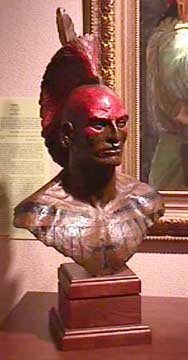 |
 |
||
|
by Jud Hartmann
|

|
||
|
"Pontiac" by Jud Hartmann (1720? - 1769) "According to Canadian tradition, he was not above middle height, though his muscular figure was cast in a mold of remarkable symmetry and vigor . . . his features had a bold and stern expression, while his habitual bearing was imperious and preemptory, like that of a man accustomed to sweep away all opposition by force of his imperious will . . . though descriptions of his appearance vary, all who mention him testify that he had an air of a commander of men; he was proud, vindictive, war-like and easily offended." Francis Parkman, "The Conspiracy of Pontiac" (1870) "He puts forth an air of majesty and princely grandeur and he is greatly honored and revered by his subjects." Maj. Robert Rogers, (1765) The fall of New France in 1761 brought to an end the pivotal role played by the Indians in the struggle between France and England for domination of the North American continent. Once courted by both powers, they were now scorned by General Jeffrey Amherst, the British Commander-in-Chief, as little more than a troublesome nuisance. The Great Lakes tribes in particular, who had supported the French king, watched sullenly as the arrogant and victorious English took possession of French forts in the Ohio country. At this juncture, the Ottawa warrior Pontiac appeared. By force of his intellect and charismatic personality he galvanized the hostility and resentment seething within 18 tribes stretching from Lake Ontario to the Mississippi. He thus became the catalyst and inspiration for the largest and most successful Indian resistance ever witnessed in North America. In a series of stunning military victories in the spring and early summer of 1763, Pontiac's forces virtually eliminated English presence in the old Northwest. Eleven English forts and outposts stretching over present-day Pennsylvania, Ohio, Indiana, Illinois, Wisconsin and Michigan were captured as the united tribes sought to prepare for the return of the French king. Thousands of settlers along the frontier were also casualties of war - killed, captured or made homeless as they fled east in panic. Only Forts Niagara, Pitt and Detroit, although besieged, remained untaken. Despite their successes, the inability of Pontiac's forces to capture the besieged forts and the failure of the French king to come to Pontiac's assistance caused the resistance to finally collapse. In 1766, Pontiac signed a treaty of peace with Sir William Johnson at Oswego in present-day New York. He then lived peacefully in the Ottawa village on the Maumee (Ohio) until he was assassinated in 1769. |
||
|
|
||
|
©2018 Lord Nelson's
Gallery ~ 1-800-664-9797 |
||